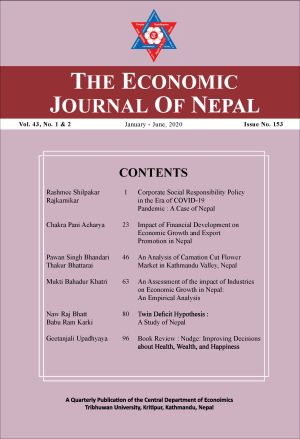Impact of Financial Development on Economic Growth and Export Promotion in Nepal
DOI:
https://doi.org/10.3126/ejon.v43i1-2.48024Keywords:
Economic growth, Financial development, Export promotion, Inflation, EconometricsAbstract
This paper explores the effect of financial development on economic growth and export promotion of Nepal using the time-series data from 1965 to 2018. The autoregressive distributed lag (ARDL) cointegration approach is used to analyze the data. In this study, financial development is measured using the credit by a bank (BNK), broad money (BMG), domestic credit to the private sector (DCP) expressed all as a percent of GDP. The control variables are final consumption expenditure (FCE), the annual increase in consumer prices (IFL), and trade to GDP (TRD). Exports of goods and services to GDP (EXP), and GDP per capita growth (ECG) are dependent variables. The effect of financial development on economic growth is statistically significant with the positive sign in both in short and long -run, but FCE is negatively significant. The impact of financial development on export performance including control variables IFL is statistically significant with a negative sign except for BRM only in the short-run; though, the TRD is positively significant. Indeed, the estimated results of the econometric estimation suggest appropriate policy corrections so that financial development can promote economic growth and export promotion.
Downloads
Downloads
Published
How to Cite
Issue
Section
License
© Cedecon-TU




